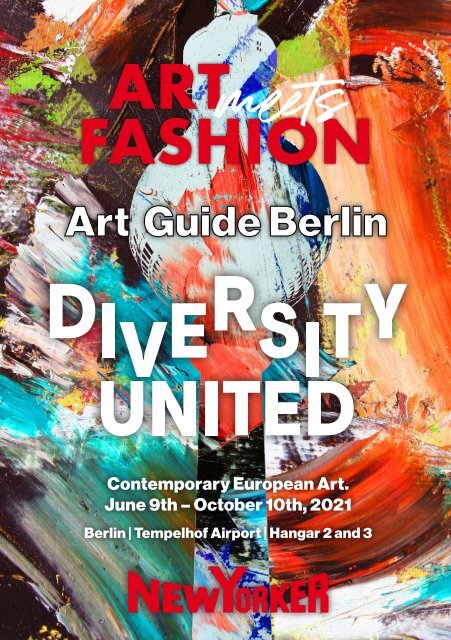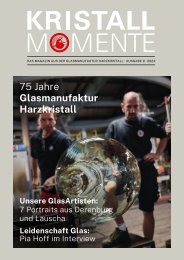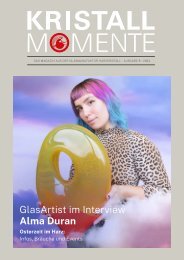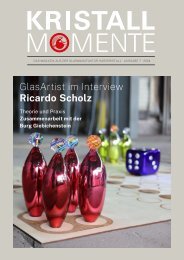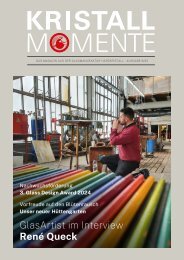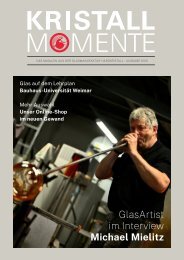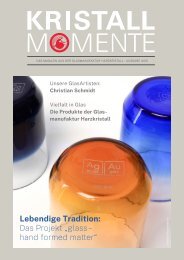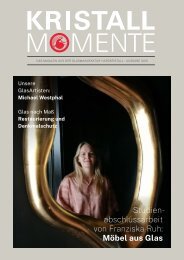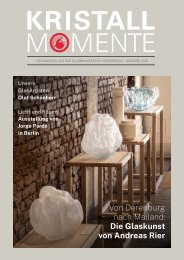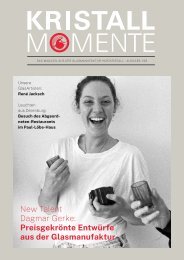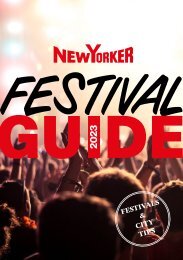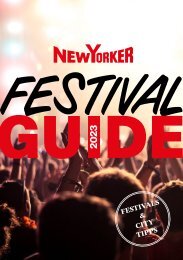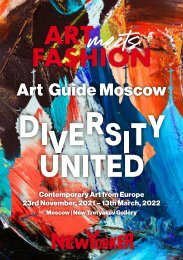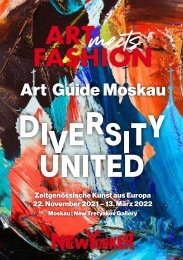NEW YORKER / Diversity United - Art Guide Berlin (english)
Diversity United is an artistic atmospheric image of contemporary Europe. The cross-border exhibition brings together painting, sculpture, video and new media, photography, installation, drawing and object art by around 90 artists from 34 countries representing different generations, genders and regions. With their works, they represent the enormous diversity and vitality of Europe‘s contemporary art scene, from Portugal to Russia, from Norway to Turkey. The exhibition sheds light on themes such as freedom and democracy, migration and territory, political and personal identity, utopias and fears; which also revolve around the current pandemic.
Diversity United is an artistic atmospheric image of contemporary Europe. The cross-border exhibition brings together painting, sculpture, video and new media, photography, installation, drawing and object art by around 90 artists from 34 countries representing different generations, genders and regions. With their works, they represent the enormous diversity and vitality of Europe‘s contemporary art scene, from Portugal to Russia, from Norway to Turkey. The exhibition sheds light on themes such as freedom and democracy, migration and territory, political and personal identity, utopias and fears; which also revolve around the current pandemic.
You also want an ePaper? Increase the reach of your titles
YUMPU automatically turns print PDFs into web optimized ePapers that Google loves.
ART<br />
FASHION
— Christian Boltanski<br />
90 artists.<br />
34 countries.<br />
1 continent in dialogue.<br />
That is <strong>Diversity</strong> <strong>United</strong>!<br />
<strong>Diversity</strong> <strong>United</strong> is an artistic atmospheric image of contemporary<br />
Europe. The cross-border exhibition brings together painting, sculpture,<br />
video and new media, photography, installation, drawing and<br />
object art by around 90 artists from 34 countries representing different<br />
generations, genders and regions. With their works, they represent<br />
the enormous diversity and vitality of Europe‘s contemporary art<br />
scene, from Portugal to Russia, from Norway to Turkey. The exhibition<br />
sheds light on themes such as freedom and democracy, migration and<br />
territory, political and personal identity, utopias and fears; which also<br />
revolve around the current pandemic.<br />
<strong>Diversity</strong> <strong>United</strong> reflects the complexity of the European mindset and<br />
its social realities in a globalised world.<br />
With its commitment, <strong>NEW</strong> <strong>YORKER</strong> once again demonstrates its<br />
close ties to the field of art, building off its established successful collaborations<br />
with the artist Jim Avignon and the art collective KLUB7.
elcome!<br />
<strong>Diversity</strong> <strong>United</strong><br />
Exhibition Facts<br />
Address:<br />
Tempelhof Airport, Hangar 2+3 / Access via Hangar 2.<br />
Columbiadamm 10, 12101 <strong>Berlin</strong>; Underground: Platz der Luftbrücke<br />
Opening hours:<br />
Mon 11 a.m. - 6 p.m. | Closed Tues | Wed-Sun 11 a.m. - 6 p.m.<br />
Tickets:<br />
Only with time slot, bookable at www.diversity-united.com<br />
Admission prices:<br />
Regular: 10,- € standard | Family: 16,- € | Children up to 16 years: free<br />
Reduced: 5,- € (for: groups of 10 persons or more, students, people with<br />
disabilities and their companion, ID required)<br />
Audio guide: 3,- €<br />
Compulsory testing / hygiene regulations:<br />
Masks are compulsory (FFP2 or OP mask) and a distance of 1.50 m must<br />
be maintained.<br />
Admission restrictions (persons per square metre) depending on current<br />
regulations / please allow for waiting time.<br />
Imprint:<br />
<strong>NEW</strong> <strong>YORKER</strong> Marketing & Media International GmbH<br />
Hansestrasse 48<br />
38112 Braunschweig<br />
Germany<br />
Editorial department: <strong>Diversity</strong> <strong>United</strong> (art contributions),<br />
<strong>NEW</strong> <strong>YORKER</strong> Music & Media (Interview, <strong>Berlin</strong>-Facts, Tempelhof Facts, Gastro and Music)<br />
Graphics: <strong>NEW</strong> <strong>YORKER</strong>, Andreas Bohn
© VG Bild-Kunst, Bonn 2021 for the works depicted;<br />
Photo installation view: Silke Briel
Prof. Walter Smerling is the founding<br />
director of the MKM Museum<br />
Küppersmühle für Moderne Kunst<br />
in Duisburg and chairman of the<br />
Stiftung für Kunst und Kultur Bonn,<br />
which is responsible for the overall<br />
organisation of „<strong>Diversity</strong> <strong>United</strong>“ at<br />
all three exhibition venues.<br />
Prof. Walter Smerling<br />
in conversation about<br />
<strong>Diversity</strong> <strong>United</strong>:<br />
When did you get the idea for „<strong>Diversity</strong><br />
<strong>United</strong>“ and what is it about<br />
the three locations <strong>Berlin</strong>, Moscow<br />
and Paris?<br />
With the Foundation for <strong>Art</strong> and<br />
Culture, we had just held the exhibition<br />
„Germany 8 - German <strong>Art</strong> in<br />
China“ in the Forbidden City in the<br />
center of Beijing. At that moment,<br />
the thought came to me: these works<br />
should surely be available in Europe?<br />
We showed the German face of art<br />
in China, at a time when there were<br />
numerous cultural difficulties. And<br />
we have seen: <strong>Art</strong> can build bridges<br />
here.<br />
At once, the idea of unity and diversity<br />
was born; „<strong>Diversity</strong> <strong>United</strong>“.<br />
With Moscow, <strong>Berlin</strong> and Paris, three<br />
locations were chosen that are both<br />
relevant today and important<br />
historically.<br />
The exhibition themes seem very<br />
complex: freedom and dignity,<br />
dialogue and conflict, political and<br />
personal identity, democracy and<br />
its erosion, (fear of) the future,<br />
solidarity and division, the consequences<br />
of the current pandemic.<br />
To what extent are these themes<br />
reflected in the selection of artists?<br />
In our selection process, we carefully<br />
analysed the artists‘ works and found<br />
that those we included in the exhibition<br />
were in line with our themes. For<br />
example, how Gilbert & George deal<br />
with everyday life with the theme of<br />
democracy. The Greek artist Angeli<br />
Dakis, for example, creates a space<br />
that the audience or the visitor can<br />
build themselves. It consists of large<br />
blocks that look like stone blocks,<br />
but made of plastic. This can be used<br />
to build an amphitheatre, for example<br />
(as was common for the ancient<br />
Greeks). And questions arise: How<br />
does democracy work? Is it the best<br />
form of government we have? What<br />
is the current situation in Europe<br />
Photo: David Ausserhofer
with its particular interests? Aren‘t<br />
there a lot of vanities right now? How<br />
do we deal with digitalization? Some<br />
artists create works that the public<br />
can find digitally on the wall. Or the<br />
juxtaposition of analogue and digital<br />
photography. The digital world also<br />
creates many fears and many communication<br />
problems, and the issues<br />
of our society are reflected in art,<br />
whether in Western, Eastern, Northern,<br />
Central or Southern Europe.<br />
being asked. Is art relevant<br />
to the system?<br />
Obviously, opinions differ on this:<br />
for me, art and culture are among<br />
the most relevant elements of our<br />
lives. <strong>Art</strong> holds the mirror in front of<br />
our eyes, we have to be alert, and<br />
our minds active. To a healthy body<br />
belongs a healthy mind. Imagine if<br />
the entire car industry, or fashion<br />
industry, for example, would not have<br />
developed the way it did without<br />
How do you explain what art is to<br />
those who are not part of the typical<br />
gallery audience?<br />
<strong>Art</strong> is a form of expression that<br />
brings together intellect and emotion,<br />
that creates something that<br />
takes hold of you and from which you<br />
cannot defend yourself emotionally<br />
or mentally. Everyone has creativity<br />
within them. A good example to<br />
explain art is the smile of the Mona<br />
Lisa. Why? Because we will never<br />
know if it expresses laughter or irony.<br />
Especially now in the crisis, the<br />
question of the status of art and<br />
culture in society is increasingly<br />
artistic influence. <strong>Art</strong> is essential for<br />
our everyday life.<br />
What comes to mind spontaneously<br />
about fashion and art?<br />
There is a close relationship. As<br />
early as the 1970s, fashion designer<br />
Yves Saint Laurent was inspired by<br />
art for his designs, specifically by<br />
Piet Mondrian and his constructive<br />
color elements. Before a structure is<br />
created, the drawing usually comes<br />
first. This is where artists and fashion<br />
designers have a lot in common in<br />
creating a piece of art or a dress. The<br />
most direct route from the head to<br />
the paper is via the arm.
City of canals and bridges.<br />
<strong>Berlin</strong> has more canals than Venice<br />
or Amsterdam and over 960 bridges.<br />
The oldest surviving bridge is<br />
the Jungfernbrücke in Mitte, built<br />
in 1798. One of the most striking<br />
is the Oberbaumbrücke, once a<br />
border crossing between East and<br />
West.<br />
Hardly a mountain in sight.<br />
<strong>Berlin</strong> is very flat, having once<br />
been a lake thousands of years<br />
ago. The highest natural mountain<br />
is the Müggelberg at 114.7<br />
metres. Somewhat higher is the<br />
Teufelsberg, but this was created<br />
from a rubble dump.<br />
Currywurst, Döner & Co.<br />
In <strong>Berlin</strong>, 70 million curry sausages<br />
are consumed every year; a<br />
separate museum has even been<br />
dedicated to the love of this dish.<br />
But doner kebab is also a tradition:<br />
there are around 1,600 doner<br />
kebab stands in <strong>Berlin</strong> - more<br />
than in Istanbul! But you can also<br />
eat without meat: with 10% of<br />
vegetarians and vegans; <strong>Berlin</strong><br />
has one of the highest rates in<br />
Europe!<br />
Well-travelled.<br />
Every day, <strong>Berlin</strong>‘s public<br />
transport system circles the<br />
globe 8.7 times.<br />
Concised culture.<br />
<strong>Berlin</strong> has 175 museums. Besides<br />
the most famous ones<br />
like the Pergamon Museum<br />
or the New National Gallery,<br />
there are also some more unusual<br />
ones like the Hemp Museum,<br />
the Museum of Illusions<br />
or the Museum of Forgotten<br />
Objects.
The exhibition location:<br />
The former <strong>Berlin</strong>-Tempelhof<br />
Airport<br />
Like hardly any other place in<br />
Europe, <strong>Berlin</strong>-Tempelhof stands<br />
for an eventful and multi-layered<br />
past.<br />
As early as the beginning of the<br />
20th century, famous aviation pioneers<br />
such as Count Ferdinand<br />
von Zeppelin or Orville Wright<br />
conducted their first flight tests<br />
on the Tempelhof field; in 1923,<br />
Tempelhof Airport was opened<br />
there and grew rapidly. In 1936,<br />
construction began on today‘s<br />
airport building, which for a short<br />
time was even the largest building<br />
in the world in terms of area.<br />
But Tempelhof is more than a<br />
landmark of engineering: the<br />
airport also became a symbol<br />
of freedom through the Airlift<br />
of 1948/49. For almost an entire<br />
year, the Allies supplied the<br />
population of West <strong>Berlin</strong>, which<br />
had been closed to land transport<br />
by the Soviet occupation, with<br />
essential goods by air. The sculpture<br />
at Platz der Luftbrücke still<br />
reminds us of this today.<br />
Civil air traffic officially began at<br />
Tempelhof in 1951; in the 1950s,<br />
the airport was one of the largest<br />
in Europe in terms of passenger<br />
volume, along with London and<br />
Paris. After German reunification,<br />
plans for <strong>Berlin</strong>‘s new major airport<br />
led to the decision to close<br />
Tempelhof, and on 30 October<br />
2008 one of the last planes landed<br />
there.<br />
Today Tempelhof is regarded<br />
as a stage for cosmopolitanism<br />
and international exchange. The<br />
Tempelhof field is used for recreation,<br />
innovative companies have<br />
settled in the listed and iconic<br />
buildings and the aircraft hangars<br />
are used for exhibitions, among<br />
other things.
Eija-Liisa Ahtila, Andreas Angelidakis, Michael Armitage, Yael Bartana,<br />
Georg Baselitz, Bluesoup, Christian Boltanski, Monica Bonvicini, Sonia<br />
Boyce, Pavel Brăila, Maurizio Cattelan, Olga Chernysheva, Tacita Dean,<br />
Rineke Dijkstra, Aleksandra Domanović, Constant Dullaart, Olafur<br />
Eliasson, Kristaps Epners, Valérie Favre, Pia Fries, Adrian Ghenie,<br />
Gilbert & George, Antony Gormley, Manuel Graf, Ane Graff,<br />
Petrit Halilaj, Mona Hatoum, Sheila Hicks, Sanja Iveković, Isaac Julien,<br />
Ilya & Emilia Kabakov, Patricia Kaersenhout, Šejla Kamerić, Anselm<br />
Kiefer, Kapwani Kiwanga, Peter Kogler, Irina Korina, Eva Kot’átková,<br />
Alicja Kwade, Kris Lemsalu, Cristina Lucas, Goshka Macuga,<br />
Kris Martin, Dóra Maurer, Annette Messager, Marzia Migliora,<br />
Boris Mikhailov, Richard Mosse, Ekaterina Muromtseva, Henrike<br />
Naumann, Mariele Neudecker, Katja Novitskova, Ahmet Öğüt,<br />
Roman Ondak, Lucy + Jorge Orta, Dan Perjovschi, Grayson Perry,<br />
Anders Petersen, Agnieszka Polska, Tal R, Paula Rego, Gerhard Richter,<br />
Ugo Rondinone, Adam Saks, Anri Sala, Fernando Sánchez Castillo,<br />
Tristan Schulze, Yinka Shonibare CBE, Katharina Sieverding, Slavs<br />
and Tatars, Nedko Solakov, Jan Svenungsson, Wolfgang Tillmans,<br />
Rosemarie Trockel, Tatiana Trouvé, Luc Tuymans, Martina Vacheva,<br />
Ulla von Brandenburg, Marko Vuokola, Rachel Whiteread, Per<br />
Wizén, Erwin Wurm, Cerith Wyn Evans, Nil Yalter, Yan Pei-Ming
We introduce some of the<br />
participating artists:<br />
© Lucy + Jorge Orta and VG Bild-Kunst Bonn, Photo: Thierry Bal<br />
Lucy and Jorge Orta: Antarctic Village<br />
The artist duo Lucy and Jorge Orta have been working with sculpture<br />
and photography as well as interventions in public space for<br />
many years. Antarctica is characterised by its natural, well-preserved<br />
landscape and its political neutrality - thanks to the Antarctic Treaty,<br />
which came into force in 1961 to regulate international relations for<br />
the protection of the Antarctic environment. For Lucy and Jorge Orta,<br />
Antarctica is a utopia for which they have made several pieces such<br />
as tents, passports and a passport office. They have created an imaginary<br />
community from all over the world, without national borders.<br />
To become a citizen of Antarctica, one must support social progress,<br />
protect the environment and human dignity, and fight for freedom,<br />
justice and peace.
Gilbert & George<br />
They present themselves as British gentlemen and do<br />
not shy away from difficult topics: Gilbert & George<br />
take up socially subversive themes. Although the<br />
artists find their content on their own doorstep, they<br />
have a global impact. Double standards and nationalism,<br />
greed and corruption, religious conflicts and terrorism<br />
are as relevant to the artists‘ neighbourhood<br />
in East London as they are to Europe and the global<br />
community. For <strong>Diversity</strong> <strong>United</strong>, the artists have conceived<br />
a self-contained „gallery“ within the exhibition,<br />
where as always they stage themselves as part of<br />
their art. With their kaleidoscopic collages of photographs,<br />
slogans, symbols and the publicly accessible<br />
pool of media images, they dissect the nervous<br />
system of a multicultural, fun-loving, technologically<br />
advanced society and act as vigilant, silent admonishers.<br />
In doing so, they use the means of masquerade to<br />
expose social and political bigotry.<br />
Courtesy of Galerie Thaddaeus Ropac, London • Paris Salzburg, © Gilbert & George
Photo: Yael Bartana<br />
Yael Bartana<br />
With her works, Yael Bartana undermines reality and questions the<br />
completeness of each individual statement.<br />
With her neon sculpture, Bartana plays with the term ‚crisis‘ and<br />
vividly demonstrates the meaning and content of this phenomenon of<br />
our time. By exchanging and rearranging some letters, she gains new<br />
words like ‚cry‘. Although Bartana‘s message is very clear, it fits all the<br />
more into our crisis-ridden world, where the word ‚crisis‘ seems to be<br />
the only important thing.
Gerhard Richter<br />
Gerhard Richter takes us on a personal journey through Europe,<br />
to places and people that he assembles into an encyclopedia of<br />
fleeting moments. He stages the dialogue between painting and<br />
photography like no other, commenting on the central questions<br />
of image and likeness, and creation and reproduction since the<br />
1960s. “Photography,“ Richter argues, „has almost no reality, it is<br />
almost 100 per cent image. And painting always has reality: you<br />
can touch the paint - it has presence; but it always makes a picture.“<br />
For <strong>Diversity</strong> <strong>United</strong>, he has chosen a small-format series<br />
of his famous overpaintings: personal photographs that he has<br />
subsequently reworked with paint. The original subject remains<br />
allusive and recognisable, but the applied paint has its own reality.<br />
Richter shows us the world and withdraws it from us again in<br />
the same moment. The painting conceals parts of the image and<br />
at the same time draws the eye to new perspectives.<br />
Private Collection, © Gerhard Richter
Courtesy of Galerie Tanja Wagner, <strong>Berlin</strong>, © ŠejlaKamerić. Photo: Hadiye Cangökçe<br />
Šejla Kamerić<br />
The starting point of Šejla Kamerić‘s works are her own experiences,<br />
memories and dreams. With a view of the past that is as impressive<br />
as it is intimate, she introduces the viewer to fundamental and critical<br />
themes and thus allows them to remain present.<br />
In Behind the Scenes (2019), Kamerić presents herself as a teenage<br />
model posing in the streets of Sarajevo during the Bosnian war. She<br />
had spontaneously borrowed the machine gun, which lies alienated<br />
on the floor as a fashion accessory, from a soldier. In the floor sculpture<br />
Liberty (2015), the word glows in white neon letters and symbolises<br />
the hope for freedom. The spikes protruding from the top, reminiscent<br />
of a bird repellent, form a strong contrast to this hope. This<br />
shows on the one hand the fragility of freedom and on the other hand<br />
the importance of protecting freedom as a common good.
Linos BBQ<br />
Malplaquetstraße 43<br />
13347 <strong>Berlin</strong><br />
<strong>NEW</strong> <strong>YORKER</strong><br />
Schultheiss Quartier<br />
Stromstraße 11-17<br />
10559 <strong>Berlin</strong><br />
Magic John’s<br />
Oranienburger Str. 48<br />
10117 <strong>Berlin</strong><br />
Further <strong>NEW</strong> <strong>YORKER</strong> stores:<br />
Tempelhof Hafen, Tempelhofer Damm 227-235, 12099 <strong>Berlin</strong><br />
Frankfurter Allee 111, 10247 <strong>Berlin</strong><br />
Marzahner Promenade 1, 12679 <strong>Berlin</strong><br />
Prerower Platz 1, 13051 <strong>Berlin</strong>-Hohenschönhausen<br />
Schlossstraße 34-36, 12163 <strong>Berlin</strong><br />
Badstraße 4, 13357 <strong>Berlin</strong><br />
Brunsbütteler Damm 40, 13581 <strong>Berlin</strong><br />
Am Borsigturm 2, 13507 <strong>Berlin</strong><br />
<strong>Berlin</strong> Forum K+, Bahnhofstr. 33-38, 12555 <strong>Berlin</strong><br />
<strong>Diversity</strong> <strong>United</strong><br />
Tempelhof Airport<br />
Hangar 2+3<br />
Access via Hangar 2<br />
Columbiadamm 10<br />
12101 <strong>Berlin</strong>
Konnopke‘s Imbiss<br />
Schönhauser Allee 44b<br />
10435 <strong>Berlin</strong><br />
Chimneys<br />
Brunnenstr. 173<br />
10119 <strong>Berlin</strong><br />
Yafo<br />
Auguststraße 43<br />
10119 <strong>Berlin</strong><br />
<strong>NEW</strong> <strong>YORKER</strong><br />
Alexanderplatz 3<br />
10178 <strong>Berlin</strong><br />
Crazy Kims<br />
Muskauer Str. 12<br />
10999 <strong>Berlin</strong><br />
Krass Böser Wolf<br />
Markgrafendamm 36<br />
10245 <strong>Berlin</strong><br />
Birgit&Bier<br />
Schleusenufer 3<br />
10997 <strong>Berlin</strong><br />
The Muted Horn<br />
Flughafenstraße 49<br />
12053 <strong>Berlin</strong><br />
<strong>NEW</strong> <strong>YORKER</strong><br />
Neukölln Arcaden<br />
and Klunkerkranich<br />
Karl-Marx-Straße 66<br />
12043 <strong>Berlin</strong>
<strong>Berlin</strong> is known for its diversity of cultural<br />
influences. And this is also reflected in the<br />
cuisine: whether Asian-vegan or an original<br />
barbecue straight from the smoker - the capital<br />
simply has more to offer than currywurst and<br />
doner kebabs.<br />
We‘re happy to report that many things are open again.<br />
All restaurant tips and opening hours are of course subject to<br />
the current Coronavirus rules. Please inform yourself about<br />
these before your visit.<br />
Linos BBQ<br />
One of the best locations for<br />
authentic American barbecues<br />
in the capital is Linos BBQ in<br />
<strong>Berlin</strong>-Wedding. The owner is a<br />
native Texan and celebrates the<br />
traditional barbecue culture from<br />
his homeland: only the best meat<br />
is served, which is cooked in a<br />
specially made smoker for up<br />
to twelve hours in hot oak wood<br />
smoke.<br />
Linos BBQ<br />
Malplaquetstrasse 43<br />
13347 <strong>Berlin</strong><br />
www.linosbbq.com<br />
Friday - Sunday from 5 p.m.<br />
Photos: Per Meurling
Handmade cakes in the Chimneys<br />
In Eastern Europe you can find them on every corner, in Germany<br />
they are seldom found: Chimney Cakes aka Baumstriezel. The café of<br />
the same name on Brunnenstrasse offers these delicacies in different<br />
variations and fillings, including vegan. There are still coffee specialties<br />
on the menu.<br />
Chimneys<br />
Brunnenstrasse 173<br />
10119 <strong>Berlin</strong><br />
www. chimneys-cafe.com<br />
Monday - Thursday: 12:30 p.m. - 9 p.m.<br />
Friday - Sunday: 12:30 p.m. - 9:30 p.m.<br />
Photos: Chimneys, Crazy Kims, Boaz Arad
Tradition meets modernity at<br />
Crazy Kims<br />
In her restaurant, Hae-Jung<br />
shows Kim just how much Korean<br />
cuisine has to offer. Traditional<br />
dishes are combined here<br />
with new culinary trends from<br />
Seoul. Definitely try: „Dödjigogi<br />
Bulgogi“, delicious, spicy marinated<br />
pork belly from the lava<br />
stone grill. And of course, there<br />
is also a large selection of meatfree<br />
dishes for vegetarians and<br />
vegans.<br />
Crazy Kims<br />
Muskauer Str. 12<br />
10999 <strong>Berlin</strong> – Kreuzberg<br />
www.crazykims.de<br />
Tuesday - Saturday: 5 p.m. -<br />
midnight<br />
Sunday: 4 p.m. - 11 p.m.<br />
Yafo: Israel in <strong>Berlin</strong><br />
Typical Israeli dishes are served<br />
in Yafo, such as hummus, various<br />
mezze, and roasted cauliflower.<br />
There is also relaxed lounge<br />
music.<br />
Yafo in the Hotel AMANO<br />
Auguststrasse 43<br />
10119 <strong>Berlin</strong><br />
www.yafoberlin.com<br />
Monday - Sunday: 1 p.m. - 7 p.m.
For a craft beer at<br />
The Muted Horn<br />
In Canada, the home of Jenia<br />
and Corbin, craft beer has long<br />
played a role. Reason enough<br />
to surprise <strong>Berlin</strong>ers with the<br />
variety of craft beer. The two bar<br />
operators have now created a<br />
piece of their old home in <strong>Berlin</strong><br />
in an urban ambience and wood<br />
and stone decor.<br />
The Muted Horn<br />
Flughafenstrasse 49<br />
12053 <strong>Berlin</strong><br />
Monday - Friday: from 5 p.m.,<br />
Saturday / Sunday: from 2 p.m.<br />
shop.themutedhorn.com<br />
Currywurst at Konnopke’s<br />
snack bar<br />
<strong>Berlin</strong> without currywurst?<br />
Unthinkable! Konnopke’s snack<br />
bar is a classic: from 1930, Max<br />
Konnopke initially provided night<br />
owls and workers with a mobile<br />
sausage stand; In 1960 he and his<br />
family built a snack bar on Schönhauser<br />
Allee, where one of the<br />
most delicious curry sausages in<br />
town is still served today.<br />
Konnopke‘s snack Schönhauser<br />
Allee 44b (under the elevated<br />
railway)<br />
10435 <strong>Berlin</strong><br />
Monday - Friday: 11 a.m. - 5 p.m.,<br />
Saturday: 12 p.m. - 5 p.m.,<br />
Closed on Sundays and public<br />
holidays<br />
Photos: Lyle Hastie, Peter Kuley, The Muted Horn
Nice view in the Klunkerkranich<br />
The Klunkerkranich offers a little improvisation, a lot of greenery and<br />
a lot of charm. The garden on the roof terrace of the Neukölln Arcaden<br />
is a café, restaurant, bar or club, depending on the time of day.<br />
Klunkerkranich on the roof of the Neukölln Arcaden<br />
Karl-Marx-Strasse 66<br />
12043 <strong>Berlin</strong><br />
www.klunkerkranich.org<br />
Thursday - Saturday: 4 p.m. - 11 p.m.
Pizza like in New York: Magic John’s<br />
Jonathan, the owner and namesake,<br />
moved from New York to <strong>Berlin</strong> in<br />
2004, where he was missing one thing<br />
in particular - New York Style Pizza.<br />
At Magic John‘s there is available: the<br />
delicious, thin pizza, which is offered in<br />
„slices“, in different varieties and with<br />
different toppings: both as a classic<br />
margherita, but also as a truffle pizza<br />
or vegan butternut pumpkin pizza.<br />
Delicious!<br />
Magic John‘s<br />
Oranienburger Strasse 48<br />
10117 <strong>Berlin</strong><br />
www. magicjohns.com<br />
Tuesday - Sunday: 12 a.m. - 11 p.m.<br />
Cocktail classics & own creations:<br />
Krass Böser Wolf<br />
Behind the unusual name is a cozy<br />
cocktail bar in <strong>Berlin</strong>-Friedrichshain.<br />
Cocktail classics are also offered<br />
alongside creations such as CocoNuts<br />
with tequila, coconut pistachios and<br />
cashews. Bottled cocktails to drink are<br />
also on the menu.<br />
Krass Böser Wolf<br />
Markgrafendamm 36<br />
10245 <strong>Berlin</strong><br />
www.krassboeserwolf.com<br />
Tuesday & Thursday:<br />
5 p.m. - 10 p.m.<br />
Wednesday & Friday-Sunday:<br />
5pm - 11pm<br />
Photos: Birgit&Bier; Krass Böser Wolf, Magic Joh‘s
Enjoy the summer at Birgit&Bier<br />
Birgit&Bier is where beer garden meets club, indoor meets outdoor,<br />
creativity meets imagination. Located directly on the banks of the<br />
locks in hip Kreuzberg, you can enjoy a freshly tapped beer or a<br />
grilled bratwurst during the day before the location becomes an<br />
open-air club with three dance floors in the evening. The fairground<br />
flair with table tennis tables, rocking horses or old carnival stalls give<br />
Birgit&Bier its very own charm.<br />
Birgit&Beer<br />
Schleusenufer 3<br />
10997 <strong>Berlin</strong><br />
http://birgit.berlin<br />
Monday - Thursday: from 2pm<br />
Friday - Sunday: from 12 o‘clock
<strong>Berlin</strong>‘s music scene is unique. Whether it‘s<br />
Rammstein, Die Ärzte, Seeed or Ton Steine<br />
Scherben - all these legendary bands have<br />
their roots in the capital. And the list is getting<br />
longer and longer with the next generation of<br />
promising musicians.<br />
Such as:<br />
Tim Bendzko<br />
Tim Bendzko was born in <strong>Berlin</strong> in 1985<br />
and grew up in the district of Köpenick.<br />
He became famous in 2011 with „Nur<br />
noch kurz die Welt retten“ and as the<br />
winner of the Bundesvision Song Contest.<br />
Ten years ago he wanted to save<br />
the world, now he prefers to live in his<br />
own. In his new single „Kein Problem“<br />
(No Problem), the singer tells of a situation<br />
in which he is stuck but wishes<br />
himself away from. For a year now, we<br />
cannot escape from the one dominant<br />
topic - the pandemic that has paralysed<br />
the world since March 2020. However,<br />
one does not want to and cannot pull<br />
oneself out of it.<br />
Bendzko also feels the confusion. If only<br />
it were as easy as in his song. In „Kein<br />
Problem“ he escapes without further<br />
ado with his soulmate, who also has no<br />
desire for the same phrases over and<br />
over again.<br />
Photo: André Josselin
Von Wegen Lisbeth<br />
In their early days, Von Wegen Lisbeth supported the<br />
Cologne-based band AnnenMayKantereit or played as<br />
opening act for music greats such as Sven Regener‘s Element<br />
of Crime, until suddenly they exploded: In 2016, the<br />
band went on their own tour across Germany, Austria and<br />
Switzerland with their debut album „GRANDE“, attending<br />
pretty much every available festival stage in the following<br />
years and quickly gained a considerable fan base.<br />
With the new tracks „Podcast“ and „L.Ost“, the <strong>Berlin</strong>ers<br />
show once again that they know how to constantly reinvent<br />
themselves lyrically and musically while remaining<br />
true to their own style.<br />
Photos: Nils Lucas; Juju
Juju<br />
<strong>Berlin</strong>-based Judith Wessendorf aka Juju is one of Germany‘s most<br />
successful rap acts. She became known with the hip-hop duo SXTN.<br />
Her first solo album „Bling Bling“ rose to No. 3 in the German album<br />
charts and the singles „Melodien (feat. Capital Bra)“ and „Vermissen<br />
(feat. Henning May)“ became No. 1 hits. It is not only her direct manner<br />
that comes across in her rap songs. With „Vermissen“ she also shows<br />
her melancholic side; by now she has an eclectic fanbase with over<br />
230 million Spotify streams and almost 9 million followers. At the end<br />
of 2019, she was awarded Best German Act at the MTV Europe Music<br />
Awards, with various other awards following. In addition to her music,<br />
the power woman also runs her own fashion label „VierVier“. In January<br />
2020, she released the single „Kein Wort“ together with Loredana,<br />
which reached number 1 in Germany and Austria. The following July,<br />
her single „Vertrau mir“ was released, followed by „2012“ together<br />
with Bausa. What‘s next? We are curious.
LEEPA<br />
LEEPA, a 22-year-old from <strong>Berlin</strong>, has a plan. She wants to change<br />
things. And not, like some who rise to success overnight gaining<br />
10,000 followers per second, but slowly. Organically. „I want a group<br />
to come together step by step that really understands what I mean. I<br />
want people who identify with me and then start working together.“<br />
Her current single is called „switch places“ - and it has an incredibly<br />
important message: in it, she deals in a positive, almost hopeful way<br />
with her everyday life as a female singer - as a woman in the mirror of<br />
our society. Instead of frustration, she approaches the subject with<br />
lightness and a strength that should make her audience sing along<br />
and think.<br />
Photo: Sony Music


